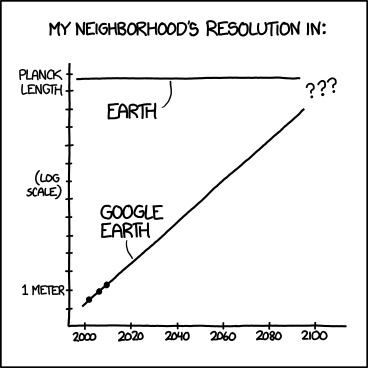Detail

2031: Google defends the swiveling roof-mounted scanning electron microscopes on its Street View cars, saying they 'don't reveal anything that couldn't be seen by any pedestrian scanning your house with an electron microscope.'

2031: Google defends the swiveling roof-mounted scanning electron microscopes on its Street View cars, saying they 'don't reveal anything that couldn't be seen by any pedestrian scanning your house with an electron microscope.'
Google Earth is a mapping software service provided by Google that allows people to view the Earth from above. If zoomed in to maximum magnification, one can obtain clear views of individual streets and homes. An image's resolution is the smallest length detectable in that image. In terms of Google Earth, this refers to the real-life distance corresponding to one pixel in an aerial image. Randall points out that the level of detail in Google Earth's images has been increasing exponentially since its introduction, as aerial imaging technology improves and better ways of collecting the data are found. Each tick in the scale represents a resolution improvement by 1000 times.In quantum mechanics, the Planck length is (in layman's terms) the smallest measurable distance, defined as approximately 1.6×10−35 meters, or around 1020 times smaller than the diameter of a proton. As the graph indicates, this may be called the "resolution" of the universe. Randall extrapolates the exponential trend of Google Earth's increasing resolution, 'revealing' that by the year 2120 or so, Google Earth's resolution will approach and even possibly exceed the Planck length, an obviously fanciful and impossible idea. Current laboratory instruments cannot even get close to measuring the Planck length, barely able to reach the level of the atom (which, by the chart's prediction, will be surpassed by Google Earth around 2040). Extrapolation and interpolation, often absurd, are recurrent topics on xkcd.
The title text refers to controversy that Google received at one point regarding their use of vehicle-mounted Street View cameras to take images of streets and houses, and how such photography could constitute an invasion of privacy. Google defended itself by stating that the cameras can see nothing more than a pedestrian walking by. Given the trendline in this comic however, Google would need to produce resolution in the nanometer range by 2031, which (using today's technology) would require the use of scanning electron microscopes. The same 'invasion of privacy' defense would obviously not work here, as 1) current scanning electron microscopes in labs can only be used with small specimens at very close range, and are completely unsuitable for observing something as large as a house or for observations from a passing car, and 2) most pedestrians are not equipped with scanning electron microscopes.[citation needed]